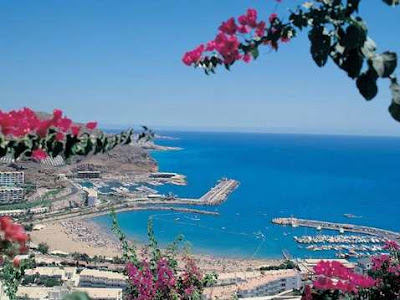Virgin Island, Exotic and beauty for travelling destination
Virgin Islands, group of about 100 small islands, West Indies, E of Puerto Rico. The islands are divided politically between the United States and Great Britain. Although constituting the westernmost part of the Lesser Antilles, the Virgin Islands form a geological unit with Puerto Rico and the Greater Antilles; they are of volcanic origin overlaid with limestone. The islands are subject to sometimes severe hurricanes between August and October and suffer from light earthquakes. The water supply is almost completely dependent on rainfall and is preserved in cisterns; some water also comes from desalinization plants.
 The tropical climate, with its cooling northeast trade winds, and the picturesque quality of the islands, enhanced by their Old World architecture, have encouraged a large tourist trade. The population is predominantly of African descent and the main religion is Protestantism. English and some Spanish and Creole are spoken. The islands were first visited by Europeans when Columbus landed on St. Croix in 1493.
The tropical climate, with its cooling northeast trade winds, and the picturesque quality of the islands, enhanced by their Old World architecture, have encouraged a large tourist trade. The population is predominantly of African descent and the main religion is Protestantism. English and some Spanish and Creole are spoken. The islands were first visited by Europeans when Columbus landed on St. Croix in 1493.Puerto Rico
A self-governing island commonwealth of the United States in the Caribbean Sea east of Hispaniola. Inhabited by Tainos when it was discovered by Columbus in 1493, it was colonized by the Spanish in the 16th century and ceded to the United States in 1898 after the Spanish-American War. Puerto Ricans were granted U.S. citizenship in 1917, although residents of the island do not vote in U.S. presidential elections. Commonwealth status was proclaimed in 1952 and has been upheld by various plebiscites since the 1960s. San Juan is the capital and the largest city. Population: 3,940,000.
 Puerto Rico is the easternmost and smallest of the Greater Antilles. Located between the Atlantic Ocean to the north and the Caribbean Basin to the south, the island is a crucial access point to hemispheric waters and coasts, representing a valuable acquisition for European powers and the United States. Columbus landed in Puerto Rico on his second voyage in 1493. The island and its indigenous people, the Taínos, were colonized by Spain, which in 1508 appointed Juan Ponce de León its first colonial governor. In 1897, after almost four centuries of colonial administration, Spain approved an Autonomic Charter for the island that entailed local self-government, elected legislators, and voting rights in the Spanish parliament. But its implementation was soon thwarted by war between Spain and the United States. The Treaty of Paris (1898) that ended the Spanish-American War placed Puerto Rico under U.S. colonial authority.
Puerto Rico is the easternmost and smallest of the Greater Antilles. Located between the Atlantic Ocean to the north and the Caribbean Basin to the south, the island is a crucial access point to hemispheric waters and coasts, representing a valuable acquisition for European powers and the United States. Columbus landed in Puerto Rico on his second voyage in 1493. The island and its indigenous people, the Taínos, were colonized by Spain, which in 1508 appointed Juan Ponce de León its first colonial governor. In 1897, after almost four centuries of colonial administration, Spain approved an Autonomic Charter for the island that entailed local self-government, elected legislators, and voting rights in the Spanish parliament. But its implementation was soon thwarted by war between Spain and the United States. The Treaty of Paris (1898) that ended the Spanish-American War placed Puerto Rico under U.S. colonial authority.Martinique - Guadalope
 Martinique is an island in the eastern Caribbean Sea, with a land area of 1,128 km2 (436 sq mi). It is an overseas department of France. To the northwest lies Dominica, to the south St Lucia. As with the other overseas departments, Martinique is also one of the twenty-six regions of France (being an overseas region) and an integral part of the Republic. As part of France, Martinique is part of the European Union, and its currency is the euro. Its official language is French, although many of its inhabitants also speak Antillean Creole (Créole Martiniquais). Martinique is pictured on all euro banknotes, on the reverse at the bottom of each note, right of the Greek ΕΥΡΩ (EURO) next to the denomination.
Martinique is an island in the eastern Caribbean Sea, with a land area of 1,128 km2 (436 sq mi). It is an overseas department of France. To the northwest lies Dominica, to the south St Lucia. As with the other overseas departments, Martinique is also one of the twenty-six regions of France (being an overseas region) and an integral part of the Republic. As part of France, Martinique is part of the European Union, and its currency is the euro. Its official language is French, although many of its inhabitants also speak Antillean Creole (Créole Martiniquais). Martinique is pictured on all euro banknotes, on the reverse at the bottom of each note, right of the Greek ΕΥΡΩ (EURO) next to the denomination.An island and overseas department of France in the Windward Islands of the West Indies. Inhabited first by Arawaks and later by Caribs, the island was visited by Columbus in 1502. It was colonized by French settlers after 1635. Fort-de-France is the capital. Population: 436,000.

